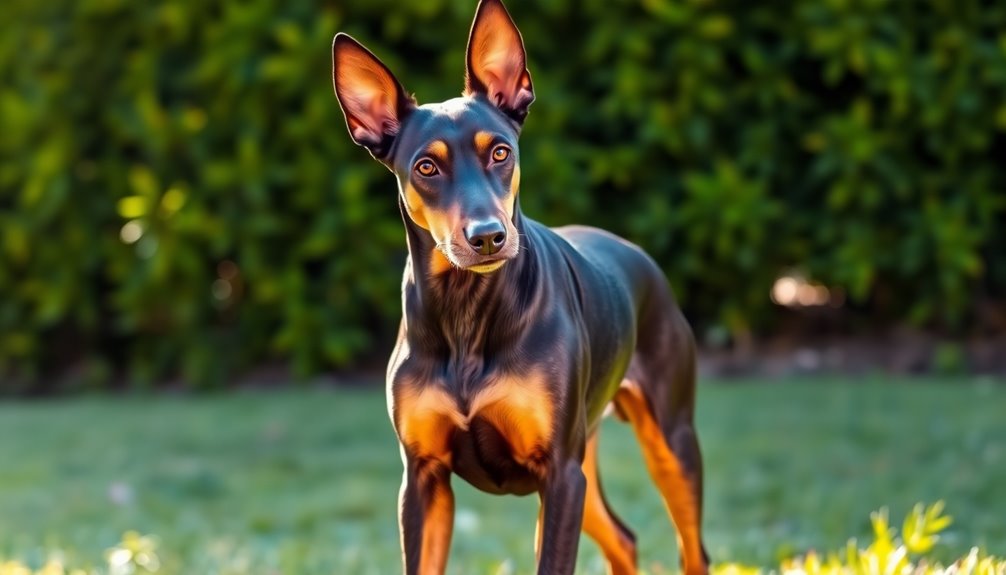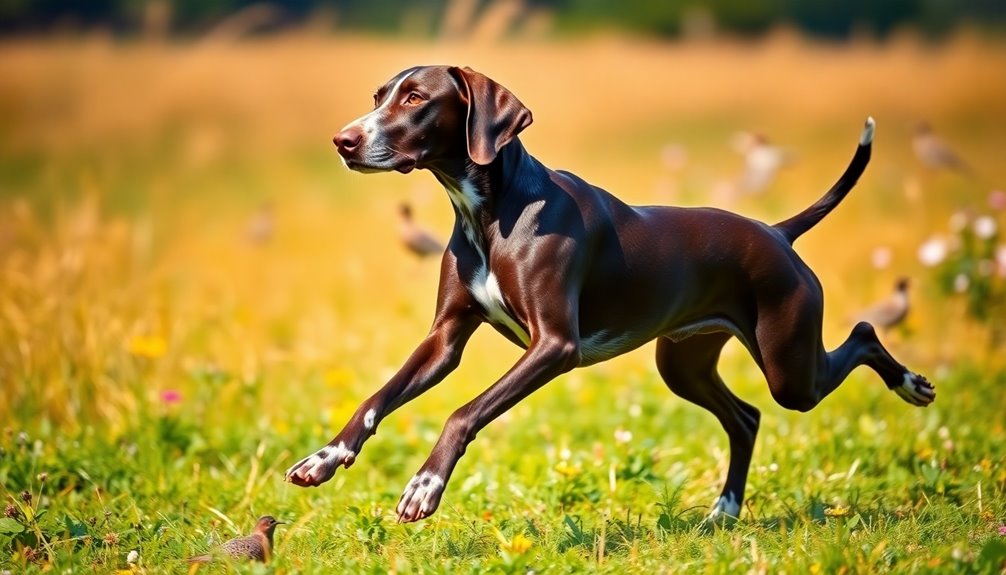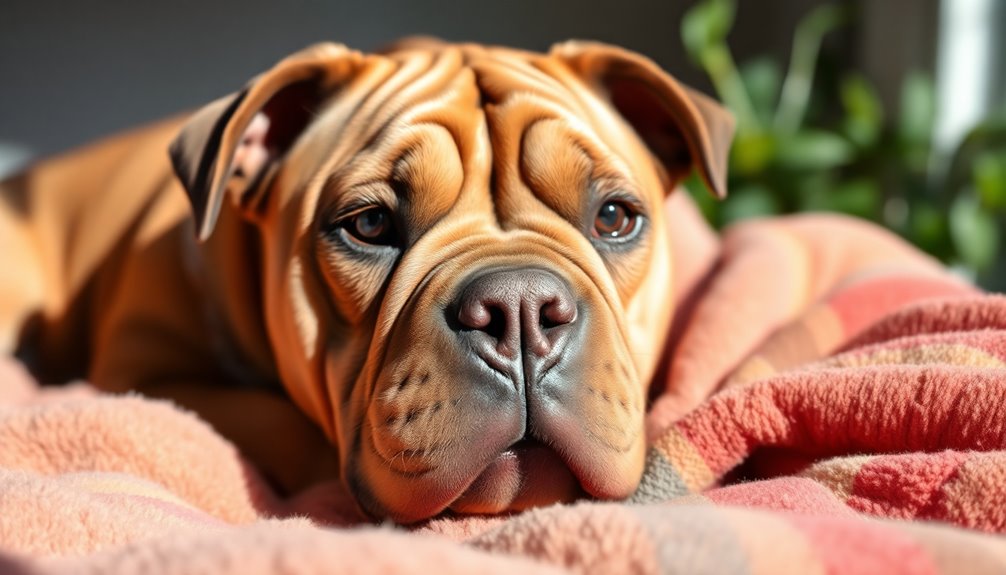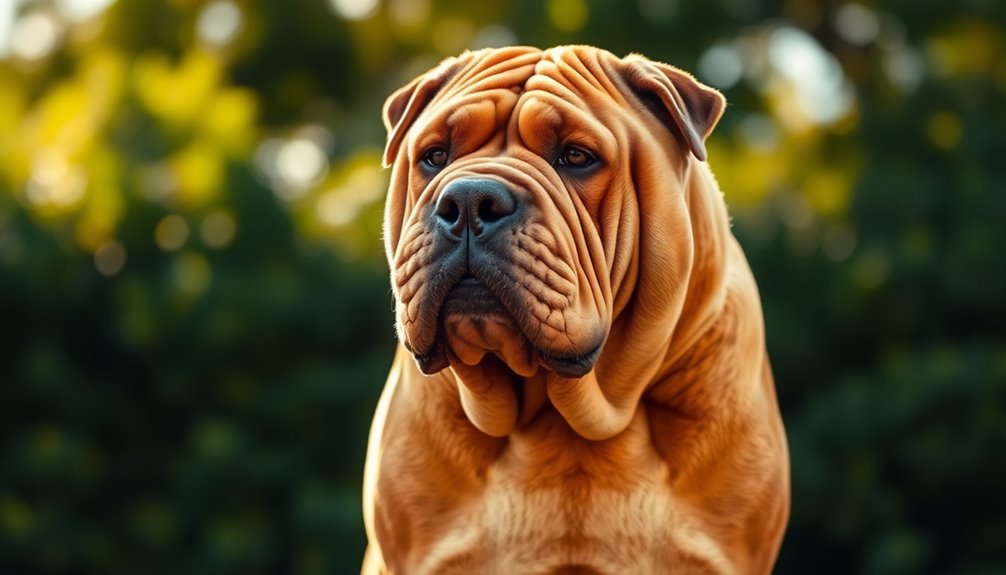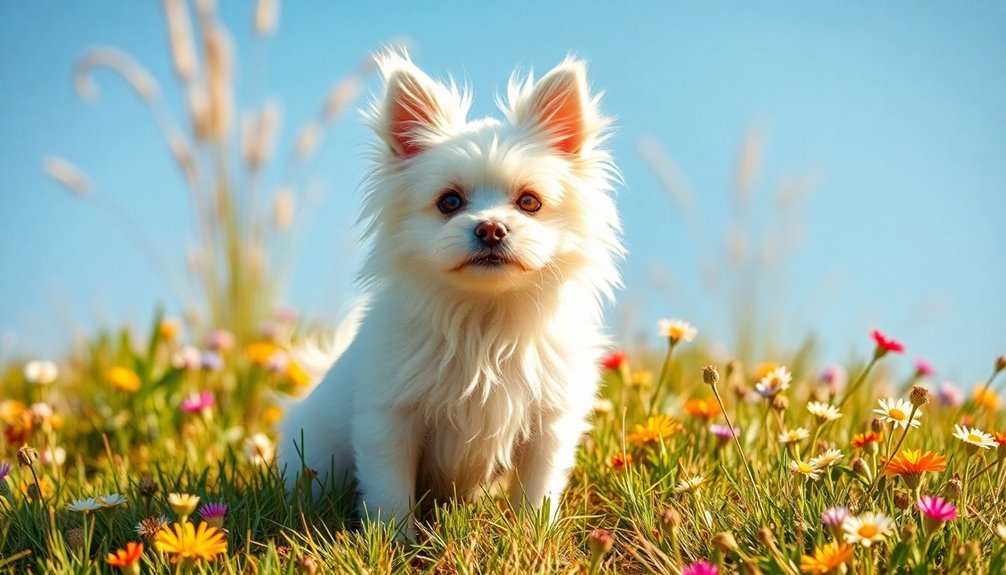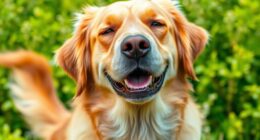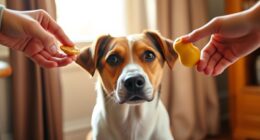The German Pinscher is a compact, confident breed that perfectly balances strength and elegance. Standing between 17-20 inches tall, these dogs are agile and energetic, making them ideal companions for active families. With a short, easy-care coat and a lifespan of 12-15 years, they require minimal grooming but need ample exercise and mental stimulation. Their protective and loyal nature makes them great family pets. Keep in mind that they thrive on socialization and training, so ensuring a well-rounded experience is crucial. If you're intrigued by their unique traits, there's much more to uncover about their history and care!
Key Takeaways
- German Pinschers are medium-sized, standing 17-20 inches tall, with a muscular build that exudes strength and elegance.
- Their short, smooth coat comes in colors like black, blue, fawn, and red with tan markings, requiring minimal grooming.
- Known for their protective nature, German Pinschers are loyal family companions and excel in providing home security.
- They thrive in active households, needing 1-2 hours of daily exercise and mental stimulation to prevent boredom.
- Early socialization and training are essential for good behavior, particularly around strangers and small animals.
Introduction
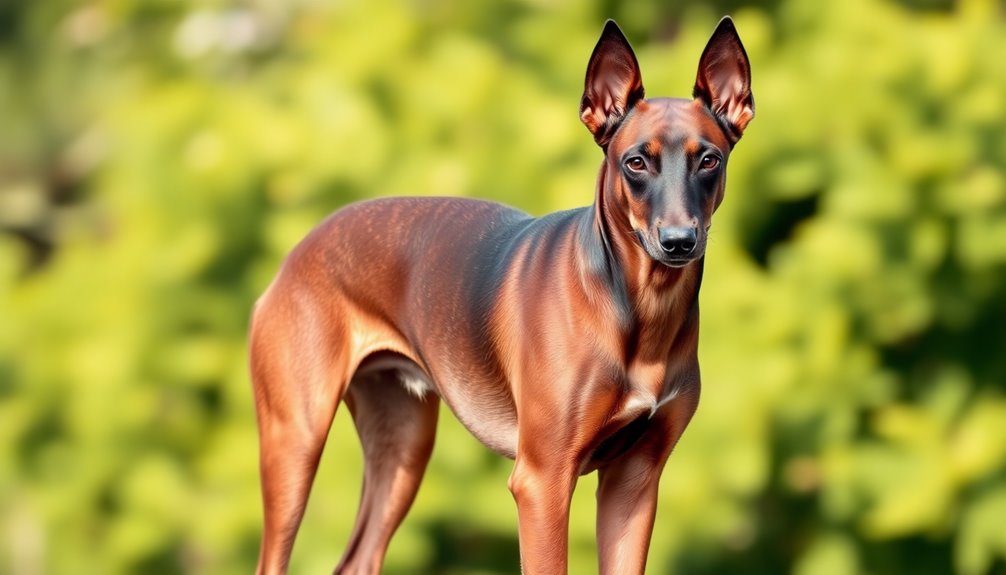
The German Pinscher is a versatile and striking breed that captures the attention of dog lovers everywhere. With its medium size, you'll notice its well-balanced and muscular build, showcasing both strength and elegance. This breed typically stands between 17 to 20 inches tall and weighs 25 to 45 pounds, making it ideal for various tasks, from agility to vermin control.
The German Pinscher sports a lean body, thin legs, and a long, wedge-shaped head, giving it an alert and attentive appearance. Their short, smooth coat comes in various colors, including black, blue, fawn, or red with tan and/or red markings, each adding to their visual appeal. The coat is low-maintenance, allowing you to enjoy your time with them without excessive grooming.
Known for their energetic and intelligent nature, German Pinschers are loyal companions who are affectionate with their families while remaining reserved around strangers. They possess a strong instinct to protect, making them excellent watchdogs. Additionally, their high energy level requires substantial physical activity and mental stimulation to keep them happy and healthy.
Their independent spirit might sometimes come off as stubbornness, but with positive reinforcement, they're highly trainable, ensuring a rewarding relationship between you and your German Pinscher.
History and Origin
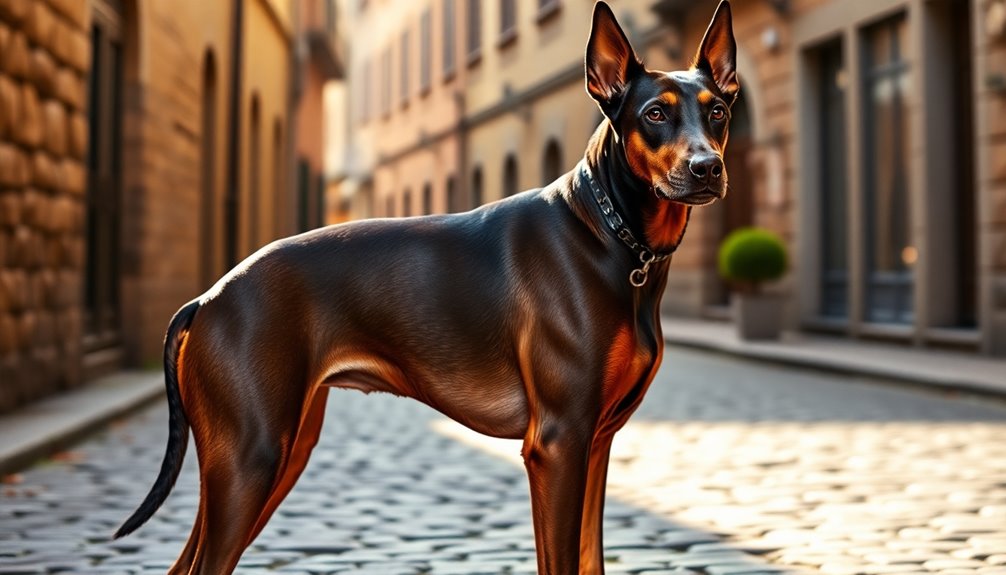
The German Pinscher originated in Germany during the 19th century, primarily as a farm dog. You'll find that these dogs were essential for controlling rats and vermin, keeping stables clean and safe. Over time, their impressive skills contributed to the development of other breeds like the Doberman and Miniature Pinscher. Their high energy levels and need for mental stimulation make them excellent companions for active families.
Where and when the breed originated
Originating in Germany during the 19th century, the German Pinscher has a rich history that reflects its development from ancient breeds. It traces its lineage back to the German Bibar of the seventh century and the Tanners of the 14th century.
By the 1600s, the breed was influenced by Black and Tan terriers, leading to the creation of the Rattenfanger, or Rattler. Early records, including drawings, date back to at least 1780, and by 1885, they were listed as smooth-coated Pinschers in German documentation.
The breed was officially defined in 1880, with the first breed standard written in 1884 and revised in 1895. It gained distinct recognition when the "Pinscher Klub" was founded by Josef Bertha in 1895, aiming to produce a short-haired dog that stood apart from other Pinscher varieties. Additionally, the German Pinscher was originally bred as stable dogs with a strong affinity for horses.
Unfortunately, the breed faced near extinction after World War II, but thanks to revival efforts by Werner Jung, modern German Pinschers largely descend from these early post-war breeding programs.
Today, they showcase a proud history that's both rich and diverse.
Rat and Vermin Control
German Pinschers were originally bred for ratting and guarding, showcasing their versatility as farm dogs. They excelled in controlling pests and protecting property and livestock, making them an integral part of German farm life.
Physical Characteristics
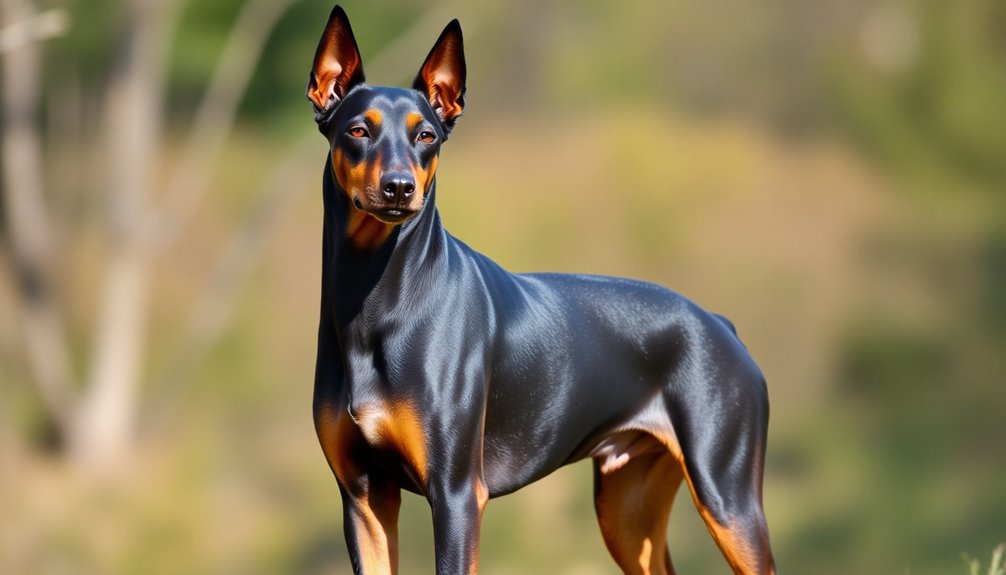
When you think about the German Pinscher, picture a strong, muscular dog standing between 17 to 20 inches tall and weighing between 25 to 45 pounds. Their lean, elegant body structure and shiny coat come in various colors like black, fawn, and red, showcasing their athleticism. These physical characteristics make them an ideal companion for medium-sized households. Additionally, their average lifespan of 12 to 15 years reflects their overall health and vitality.
Size, weight, and coat details
What makes the German Pinscher stand out in the canine world is its well-proportioned size and robust physique. Typically, these dogs measure between 17 to 20 inches tall, with males being slightly taller than females. Their compact size allows them to navigate various terrains and access smaller spaces, making them ideal for activities like vermin control and search missions.
When it comes to weight, German Pinschers range from 25 to 45 pounds. This weight range strikes a perfect balance between strength and agility, supporting their energetic nature and versatility as working dogs. Both male and female Pinschers fall within this weight spectrum.
Their coat is another notable feature. They've short, dense fur with a double coat, consisting of a soft undercoat and a harsher outer layer that repels dirt and water. This coat requires only occasional brushing to stay healthy and acts as a protective barrier against different weather conditions. Additionally, their low-maintenance coat allows for easy grooming, making them suitable for busy owners.
In terms of color, you'll find solid shades like red, black, blue, and fawn, often with tan markings. These color variations enhance the breed's visual appeal and individuality, showcasing their unique characteristics.
Strong, Muscular Build
With their well-proportioned size and sturdy physique, these dogs are built for strength and agility. The German Pinscher features a compact, square build, with body length matching their height at the withers. You'll notice their muscular loins and a short distance from the last rib to the hip, contributing to their flexibility. Their moderately wide chest, well-sprung ribs, and deep brisket that descends to the elbows enhance their athletic appearance. The elegant yet strong neck, combined with a firm back, indicates impressive power.
Their straight, level back flows into well-muscled loins, while straight, well-boned forelegs maintain a perfect vertical stance. As they move, these dogs exude confidence, showcasing their muscular structure in a relaxed manner. High energy levels make the German Pinscher lively and enthusiastic companions, adding to their dynamic presence.
With a long, wedge-shaped head and attentive eyes, the German Pinscher captures your attention. Their naturally erect ears add to their alert demeanor.
The moderately docked tail, set above horizontal, complements their strong build. Overall, the German Pinscher presents an elegant yet powerful silhouette, reflecting endurance and agility in every step they take.
Temperament and Personality
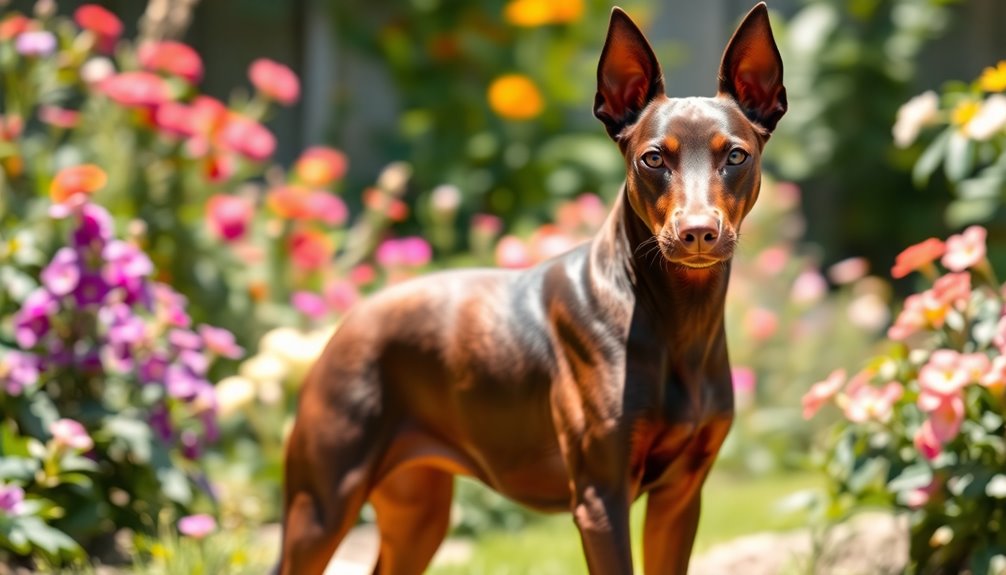
The German Pinscher's protective and alert demeanor makes them excellent companions for families and individuals alike. You'll find that their loyalty and vigilance can create a strong bond, ensuring your home feels secure. With the right socialization, they can also coexist well with other pets, adding to their charm as a versatile family member. Their history as multi-purpose farm dogs highlights their adaptability and usefulness in various roles within the family.
Protective and Alert Demeanor
How does the German Pinscher balance its protective instincts with a loyal demeanor? This breed is naturally inclined to safeguard your home and family, thanks to its territorial nature.
With a strong defensive instinct, the German Pinscher makes an excellent guard dog, alerting you to potential threats with a firm bark. While not inherently aggressive, it can act defensively if it feels threatened or hasn't been properly socialized. Their high alertness and keen senses mean they're quick to respond to unusual activity, making them vigilant watchdogs. However, managing this protective behavior requires consistent training and early socialization. Using positive reinforcement methods works best; it helps balance their vigilance with well-mannered behavior. Additionally, their intelligence and versatility allow for effective training and engagement in various activities. Feeding them the right diet, such as vet-approved recommendations, can also support their overall health and energy levels.
The overall temperament of the German Pinscher is confident and loyal, forming strong bonds with you and your family. While they're energetic and playful, they also enjoy social interactions.
Suitability for families, individuals, or other pets
For families, German Pinschers can be a fantastic choice if you have older children who can handle their energetic and intense nature. They thrive in active households, needing regular exercise and mental stimulation. You'll find that they bond closely with family members, making them loyal and loving companions. Additionally, their protective nature makes them excellent watchdogs, providing security for your home.
However, they require early training and socialization to behave well around everyone.
If you're an individual considering a German Pinscher, be prepared for a strong-willed dog that suits experienced owners. Your activity level should match theirs, as they need plenty of exercise. They can adapt to smaller living spaces, but you must commit time to training and socialization.
When it comes to other pets, German Pinschers can be more challenging. They've a high prey drive, so keeping them away from small animals like rodents is crucial.
While they might get along with cats or other pets, early socialization is essential to prevent aggression. Introducing them to new pets requires careful planning, as without proper guidance, they might view smaller animals as prey.
Health and Lifespan
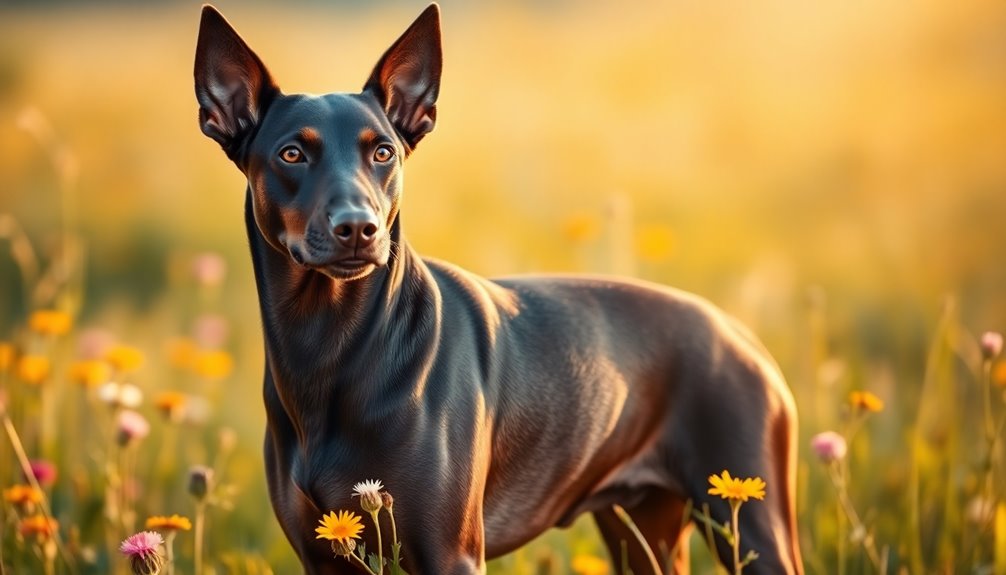
When it comes to your German Pinscher's health, being aware of common issues like hip dysplasia and eye problems is essential. This breed typically lives between 12 to 14 years, but with proper care, you can help them thrive longer. Regular vet visits and a balanced diet contribute significantly to their overall health.
Typical lifespan of the breed
German Pinschers typically enjoy a lifespan of 12 to 14 years, though with proper care, some can even live up to 15 years. To ensure your Pinscher reaches the upper end of this range, focus on providing a balanced diet tailored to their specific needs. Nutrition plays a vital role in their overall health and longevity.
Regular exercise is crucial, not only for their physical fitness but also for their mental well-being. Engaging in activities like obedience training, agility, and tracking can keep their minds sharp and prevent boredom. You should also incorporate puzzle toys and interactive games into their routine for added stimulation. Additionally, regular veterinary visits are crucial for managing health risks, ensuring early detection of potential issues. Consistent interaction with other dogs is important for puppy socialization, enhancing their adaptability and confidence.
Routine veterinary check-ups are essential for monitoring their health, including vaccinations and dental care. Weight management is another important factor, as it helps prevent conditions like hip dysplasia.
Creating an active household environment where your German Pinscher can thrive is key. Early socialization and consistent training will foster a well-adjusted companion.
Common health concerns or genetic predispositions
What health concerns should you be aware of when it comes to the German Pinscher? This breed is prone to several genetic issues that could impact their quality of life.
One of the most common concerns is cataracts, particularly in older dogs, with a prevalence of 15.6%. These can lead to blindness and significant pain if untreated. Furthermore, regular veterinary check-ups are recommended for early detection of health issues, ensuring timely management of any emerging conditions.
Hip dysplasia is another concern, affecting the hip joint and potentially leading to mobility issues. While genetic, a proper diet and regular exercise can help mitigate this risk.
Heart problems are significant as well, with heart valve disease being a leading cause of death among older Pinschers. Symptoms like coughing and fainting can indicate issues like pulmonic stenosis, requiring early diagnosis and monitoring.
Additionally, don't overlook parasitic and infectious diseases. Year-round prevention against fleas, ticks, and heartworms is crucial, as these can cause severe health problems.
Vaccinations are also vital to protect against various bacterial and viral infections. By being aware of these health concerns, you can take proactive steps to ensure your German Pinscher lives a healthy, happy life.
Tips for maintaining health and wellness
Maintaining the health and wellness of your German Pinscher goes beyond being aware of potential health concerns. Start by providing high-quality dog food tailored to your pup's age, size, and activity level. Consult your veterinarian for specific dietary recommendations, and avoid feeding table scraps to prevent obesity and related health issues. Always ensure access to fresh water.
Daily exercise is crucial. Engage your Pinscher with running, agility training, and long walks. Interactive toys and playtime will help meet their exercise needs, while activities like obedience training and agility courses keep them fit and mentally stimulated. Regular exercise is essential for helping to manage their energy levels.
Balance physical activity with rest periods to avoid overexertion.
Mental stimulation is just as important. Incorporate obedience training, puzzle toys, and challenging games to keep their minds sharp, and don't forget regular social interaction through visits to dog parks.
Routine care is essential too. Regularly groom your Pinscher, check their ears, trim nails, and monitor their overall health.
Schedule veterinary check-ups for vaccinations, parasite prevention, and dental care. By following these tips, you'll help ensure a long, healthy life for your German Pinscher.
Care Requirements
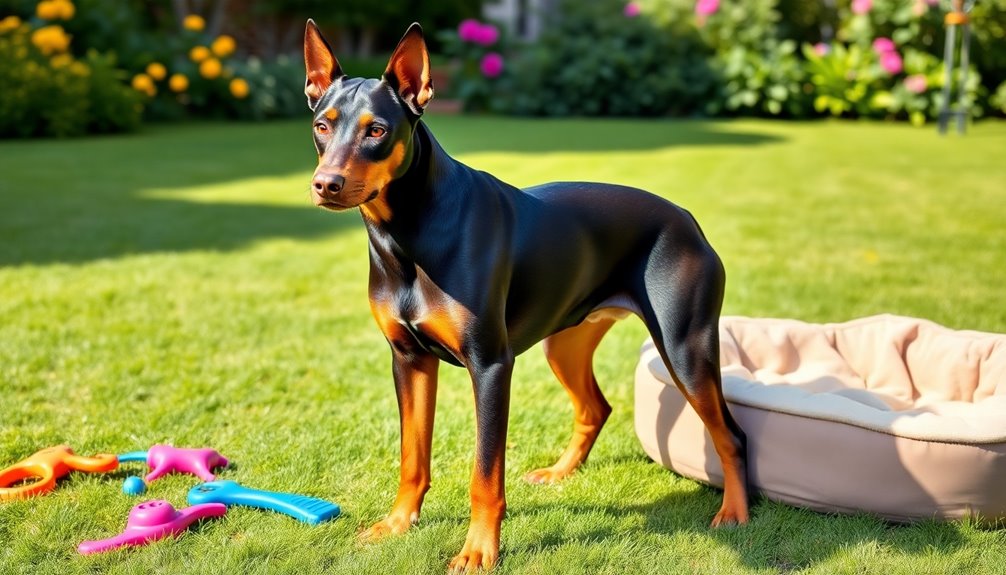
Caring for a German Pinscher involves understanding their grooming needs and high energy levels. You'll find their short coat requires minimal shedding and easy grooming, but regular exercise is crucial to keep them happy and healthy. Additionally, knowing the right diet can enhance their overall well-being and vitality. Providing consistent exercise is essential to prevent boredom and negative behaviors, making it a vital part of their care routine. Incorporating activities that mimic their natural instincts, such as proper disposal habits, can further enrich their daily routine and promote a healthy lifestyle.
Minimal Shedding, Easy Grooming
The German Pinscher boasts a short and shiny coat that makes grooming a straightforward task. With moderate shedding, you'll notice a bit more hair around your home during spring and fall, but regular brushing can help manage this. Aim for weekly brushing to remove dead hair and distribute skin oils for a healthy coat. In addition to their grooming needs, it's important to note that the German Pinscher is an energetic and intelligent breed, requiring regular exercise to maintain their overall well-being.
During shedding seasons, increase your brushing frequency to keep loose hair at bay. Bathing is generally needed every 4-6 weeks, depending on your dog's lifestyle. Use a rubber curry brush or short-bristle brush for effective grooming.
Regular maintenance, such as nail trimming, ear cleaning, and teeth brushing, is essential for your Pinscher's overall health. Daily dental hygiene is particularly important to prevent dental issues.
While the German Pinscher doesn't require special skin care, good nutrition plays a crucial role in maintaining their skin and coat health. For added shine, consider finishing touches with a grooming mitt or an Aloe Hydrating Spray.
With these simple grooming practices, you'll find that keeping your German Pinscher looking great is low-maintenance and enjoyable.
Exercise requirements and energy levels
Keeping your German Pinscher well-groomed sets the stage for a healthy lifestyle, but exercise is where their energy truly shines. These active dogs need at least one to two hours of daily exercise to burn off their excess energy effectively. You should incorporate brisk walks or jogs into your routine, ensuring they get the physical activity they crave.
Engaging your Pinscher in one-on-one play sessions, like fetch or tug-of-war, is essential to keep them stimulated. They also excel in endurance sports, so consider hiking or running with them. Participating in dog sports such as obedience, agility, or tracking can channel their drive productively.
Don't forget about mental stimulation; interactive toys and problem-solving activities can help prevent boredom and destructive behaviors. Regular training sessions not only keep their minds sharp but also strengthen your bond. Their high intelligence makes them quick learners, which is beneficial during training.
Establishing a structured routine with clear boundaries and expectations will help manage their high energy levels. Ultimately, combining physical and mental activities in your daily routine will keep your German Pinscher happy, healthy, and well-adjusted.
Feeding tips and diet recommendations
Feeding your German Pinscher a balanced diet is crucial for their overall health and vitality. Active adult Pinschers typically need around 1109 kcal per day, while puppies require about 733 kcal. If your adult dog engages in high-energy activities, they may need up to 1849 kcal daily. It's important to note that German Pinschers have a high energy level that necessitates regular exercise and a structured routine alongside their diet.
Focus on a diet rich in protein, fat, and fiber, avoiding excessive calcium to prevent orthopedic issues in puppies.
Opt for high-quality dog food that suits your dog's digestive system. Choices like Canidae Grain Free Pure Foundations and Vital Essentials Raw Pet Food are excellent options, especially for those with food sensitivities.
For senior dogs, consider diets with higher protein and lower carbs, such as Nulo Freestyle Senior Trout & Sweet Potato Recipe.
Keep snacks healthy and low-calorie—carrots, apples, and green beans work well. Steer clear of table scraps to avoid harmful ingredients.
Always consult your veterinarian for specific dietary recommendations and portion sizes, especially for pregnant or nursing dogs.
With the right nutrition, your German Pinscher will thrive and maintain their energetic lifestyle!
Training and Socialization
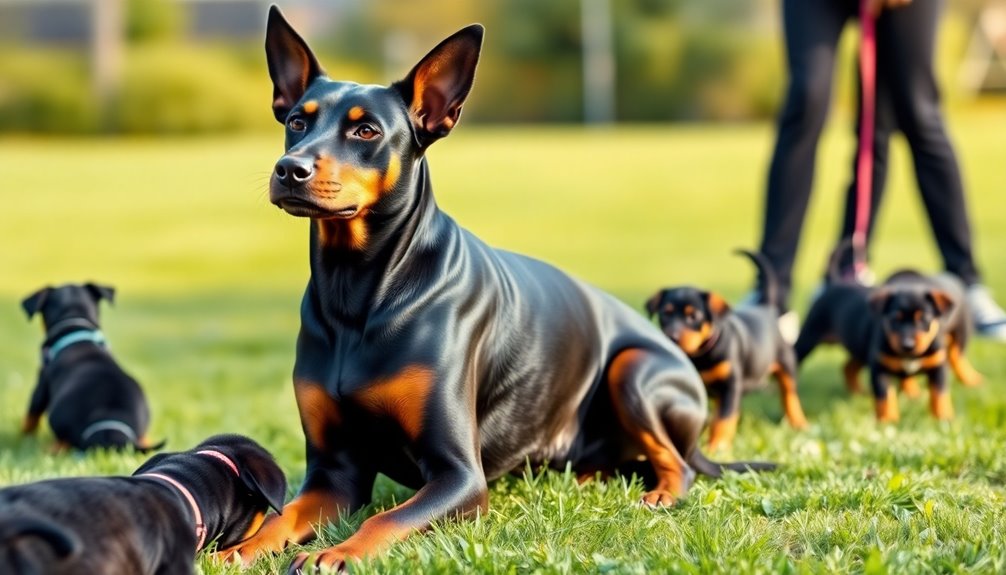
When training your German Pinscher, you'll quickly notice their intelligence and eagerness to learn. Gradual exposure to new environments is essential for their adaptability, helping them manage leash reactivity and develop impulse control. Additionally, incorporating positive reinforcement during training sessions can significantly enhance their learning experience and motivation.
Highly Intelligent and Eager
German Pinschers are remarkably intelligent and eager to learn, making them one of the most trainable breeds. Their sharp intellect and working-dog heritage enable them to grasp commands quickly, excelling in obedience, agility, and complex problem-solving tasks. To harness their full potential, you should begin training early, establishing consistent and patient routines that keep their minds actively engaged. Additionally, understanding their emotional stability can enhance training effectiveness.
Utilizing positive reinforcement techniques, like treats and praise, will encourage good behavior and repetition of commands such as "sit," "stay," and "come." It's essential to maintain an ongoing training process, as this breed thrives on challenges and mental stimulation. Remember to avoid harsh responses; instead, focus on rewarding positive actions. Due to their strong-willed nature, assertive yet gentle guidance is necessary.
Incorporate structured training sessions into your daily routine, making it a fun and rewarding experience for both you and your German Pinscher. By fostering an environment of encouragement, you'll help your dog develop into a well-mannered and confident companion, ready to tackle any challenge that comes their way. Additionally, regular training enhances the dog's overall behavior, ensuring they remain a well-adjusted member of your family.
Gradual Exposure to New Environments
Early exposure to new environments is crucial for German Pinschers, as it shapes their behavior and confidence. By introducing them to various people, animals, sounds, and settings from a young age, you help prevent fear-based aggression and anxiety. It's important to socialize them in a controlled manner, fostering a friendly and adaptable demeanor that leads to well-adjusted, confident adults. Use positive reinforcement techniques—treats and praise—to encourage good behavior throughout this process.
Incorporating the right developmental practices into their routine will also aid in their overall growth.
Gradually acclimate your German Pinscher to "alone time" through crate training, addressing any potential separation anxiety. Engage in one-on-one play sessions and interactive activities to keep them mentally stimulated and entertained. Incorporating obedience training and teaching new tricks won't only sharpen their minds but also strengthen your bond. Basic obedience training is essential for teaching them commands that can be useful in various situations. Well-socialized German Pinschers are courageous and typically unafraid of new situations.
They form strong, affectionate relationships with family members and can get along well with children and other pets when interactions are supervised. Start socialization as early as possible, weaving training sessions into daily routines to keep their sharp minds engaged. This proactive approach ensures a happy, well-rounded companion.
Leash Reactivity and Impulse Control
Leash reactivity can be a common challenge for German Pinschers, but with the right training and socialization strategies, you can effectively manage and reduce this behavior. Start by avoiding situations where your dog can meet other dogs while on leash, preventing negative associations. When encountering new people, ask your dog to sit beside you and reward them with treats for appropriate behavior.
Use a standard leash instead of a retractable one to maintain better control. Avoid corrective collars, as they can heighten reactivity. Instead, make yourself more interesting to your dog than any potential triggers. Teach your dog a marker word like "Yes" to signal good behavior and reward them with high-value treats. Leash reactivity often stems from frustration or fear when dogs are restrained, so it's important to understand the underlying causes. Engaging in regular play with active toys can help release pent-up energy, making your dog more focused during training sessions.
Practice indoors with a helper to simulate triggers before heading outside. To develop impulse control, incorporate training into daily routines, like waiting for food or before going outside. Use games like fetch to reinforce cues while burning off energy.
Focus on keeping your dog calm around distractions and gradually decrease the distance from triggers as they become more reliable. With patience and consistency, you can help your German Pinscher master impulse control and leash manners.
Ideal Living Environment
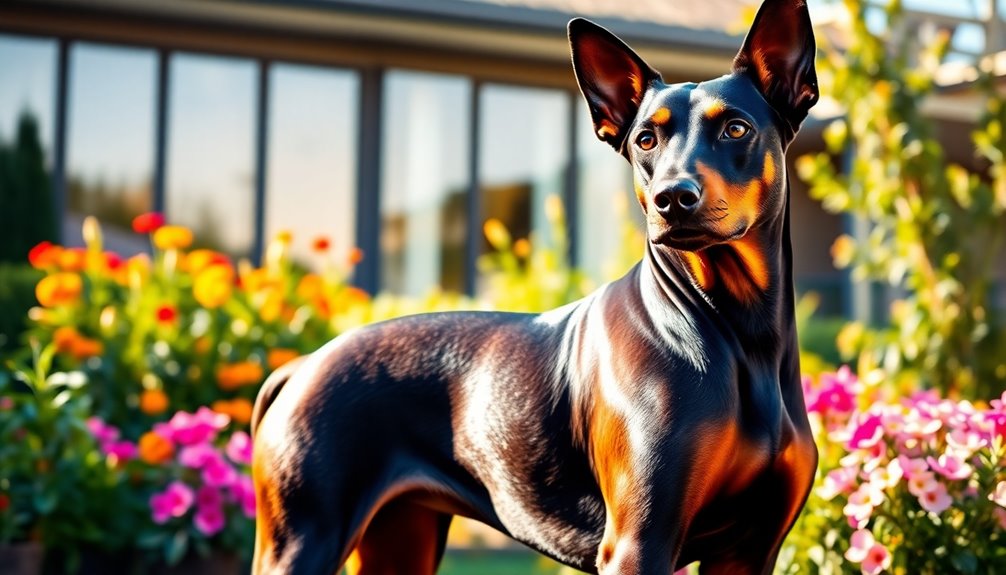
If you live in an urban apartment, a German Pinscher can thrive as long as you have access to nearby parks. These dogs need regular outdoor activity, so having green spaces for walks and playtime is essential. Plus, they adapt well to moderate temperatures, making them suitable companions for various climates. Their high energy levels require ample exercise to keep them happy and healthy. Additionally, ensuring your living space is secure can be beneficial for both you and your pet, so consider investing in a home security system to protect your environment.
Urban Apartment With Access to Parks
Living in an urban apartment can be a great fit for a German Pinscher, as long as you ensure they get enough exercise and mental stimulation.
These compact and confident dogs can adapt well to smaller living spaces if you commit to daily walks and interactive play sessions. Regular outdoor activities are crucial; without them, your Pinscher might become bored and develop undesirable behaviors. Additionally, their high intelligence means they thrive when engaged in challenging activities that stimulate their minds.
Access to parks is highly beneficial for this breed. Parks provide ample space for them to run freely and socialize off-leash, helping to channel their energy positively. Engaging in activities like fetch or agility at these locations not only meets their moderate to high exercise needs but also satisfies their natural instincts to explore.
In an urban setting, make it a point to incorporate vigorous walks, dog sports, and other physical activities into your routine. This way, you can ensure your German Pinscher remains happy and healthy.
Remember, early socialization and consistent training will help your dog thrive in the bustling environment, aiding them in becoming a well-rounded, confident companion.
With dedication, an urban apartment lifestyle can be incredibly rewarding for you and your Pinscher.
Moderate Temperature Tolerance
Understanding the German Pinscher's moderate temperature tolerance is essential for creating an ideal living environment. These dogs don't have the same cold tolerance as some breeds due to their lack of a thick, insulating coat. Without specialized adaptations like furry feet or water-resistant fur, prolonged exposure to cold can be uncomfortable and even hazardous for them. This is particularly important as Miniature Pinschers are known for their high cold sensitivity, which can affect their overall well-being.
To keep your German Pinscher comfortable indoors, maintain a stable temperature around 68-72°F (20-22°C). Ensure their environment is draft-free and provide cozy beds to help retain warmth. Sudden temperature changes should be avoided, as they can lead to discomfort or cold-related health issues.
When it comes to outdoor activities in colder weather, keep walks short and brisk, and consider outfitting your dog with protective clothing like coats or sweaters. Indoor play can serve as a great alternative to outdoor exercise during chilly days.
In hot climates, make sure your Pinscher has access to shade and water to prevent overheating. Remember, their adaptability to different climates largely depends on the care you provide, so monitor their behavior closely to ensure they're comfortable.
Versatile Working Dog History
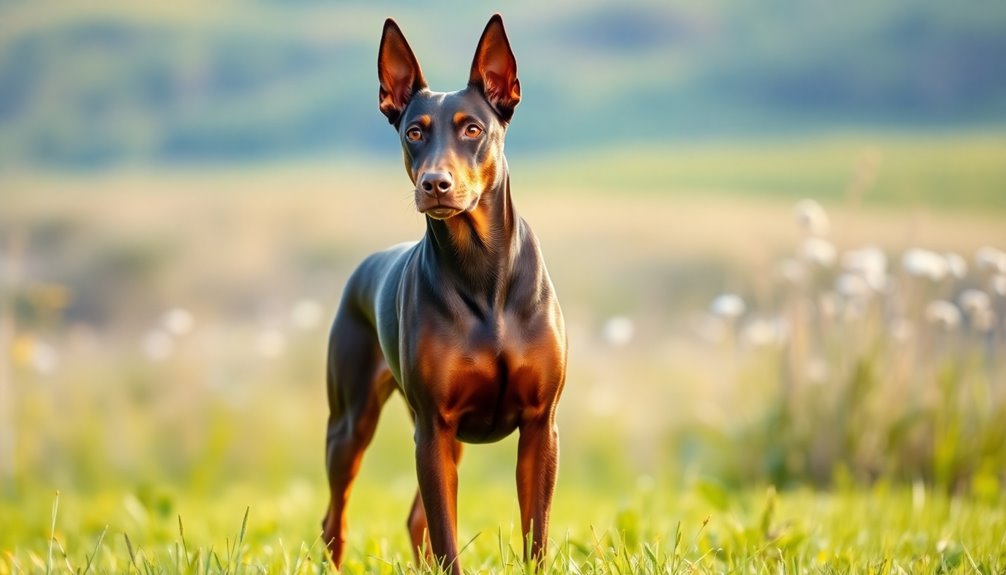
The German Pinscher holds a unique place in canine history as the first standard breed established in Germany. You might recognize this remarkable dog from its appearance in 'The Hunger Games', showcasing its versatility and strength. Understanding its origins and contributions can deepen your appreciation for this exceptional working breed. The breed was originally developed as a stable dog for protection and vermin extermination in the 19th century.
First Standard Breed in Germany
German Pinschers stand out as one of the first standardized breeds in Germany, showcasing a rich history as versatile working dogs. Originating in the 19th century, these dogs were primarily utilized as stable-dogs to protect property and eliminate vermin.
They descend from the Rat Catcher and Great Ratter, and their lineage includes both rough-haired and smooth-haired varieties. The rough-haired type eventually evolved into the Standard Schnauzer, while the smooth-haired Pinscher was recognized as early as 1836 by Heinrich Gottlieb Ludwig Reichenbach.
The breed was officially defined in 1880, with its first standard written in 1884 and revised in 1895. This standardization led to the formation of the Pinscher-Schnauzer-Klub that same year.
As a result of dedicated breeding efforts, the smooth-haired Pinscher gained distinct recognition. These dogs excelled in various roles, proving to be exceptional at pest control and as vigilant watchdogs, and they continue to thrive in dog sports today. Additionally, their high energy requirements make them well-suited for active families who can provide the necessary exercise and mental stimulation.
Though the breed faced near extinction after World War II, it was revitalized by Werner Jung in the 1950s, ultimately achieving recognized status in 1955.
Featured in 'The Hunger Games
With a history rooted in versatility and tenacity, the German Pinscher's remarkable traits have even found their way into popular culture, notably in 'The Hunger Games.' In this dystopian narrative, characters rely on their instincts and adaptability, much like these dogs.
Originally bred in 17th-century Germany, German Pinschers were exceptional vermin hunters, controlling pests on farms and protecting livestock. Their vigilance, keen intelligence, and strong prey drive made them invaluable companions for farmers. Additionally, their muscular build and agility enable them to excel in various physical tasks.
These dogs didn't just hunt; they also served as watchdogs, showcasing their multitasking capabilities. Whether patrolling for pests or guarding homes, their agility and quick intellect allowed them to excel in various tasks, including dog sports. With their protective nature and instinctual desire to safeguard family, they strike a perfect balance of vigilance and discernment.
Today, German Pinschers thrive in competitive environments, mastering agility, tracking, and obedience. Their intelligence and resourcefulness shine in complex problem-solving scenarios, reflecting their versatile working dog history.
Active Lifestyle Compatibility
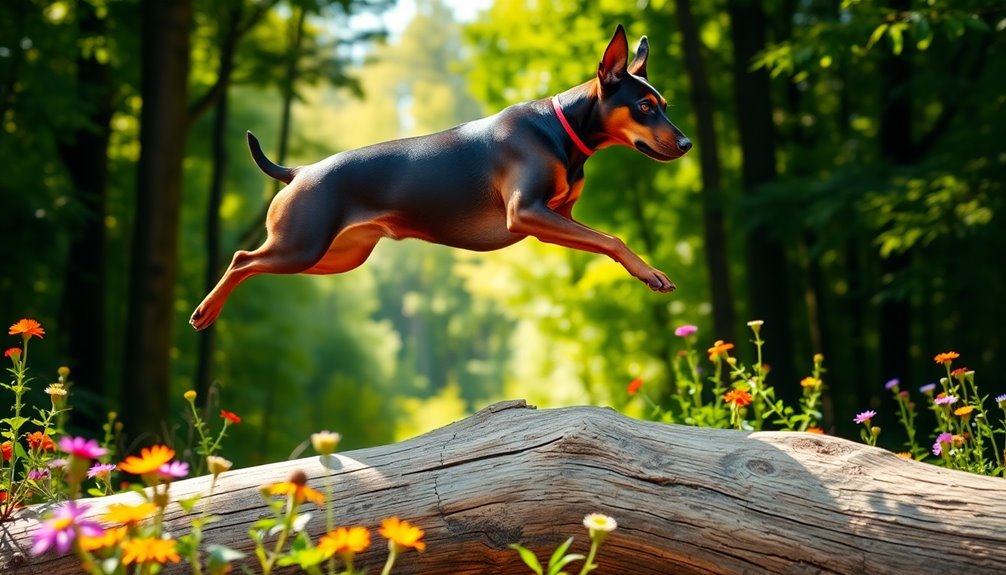
If you lead an active lifestyle, a German Pinscher could be the perfect companion for you.
They thrive on exercise and need a committed owner to keep up with their energy levels through training and outdoor activities.
Engaging in regular physical and mental challenges will keep them happy and well-behaved.
Ideal for Active Individuals
Looking for a dog that can keep up with your active lifestyle? The German Pinscher might just be your perfect match. This breed thrives on physical activity, requiring at least one to two hours of exercise each day.
Whether you enjoy brisk walks, runs, or energetic games of fetch, your German Pinscher will eagerly join in. Their endurance makes them excellent running or biking companions, perfect for those who love outdoor adventures like hiking and camping.
If you engage regularly in physical activities, this breed will fit seamlessly into your routine. They also excel in dog sports, such as agility and obedience, giving you plenty of opportunities for bonding and fun.
However, it's essential to provide mental stimulation alongside physical exercise to keep them happy and prevent boredom. Interactive toys and problem-solving games will help channel their energy positively.
While they can adapt to apartment living, access to a securely fenced yard is ideal for allowing them to run freely.
If you're ready to commit time and energy to an active lifestyle, a German Pinscher will be a loyal and enthusiastic companion every step of the way.
Training Commitment Required
Training a German Pinscher consistently is crucial for their development and well-being. This breed thrives on daily training and exercise, requiring at least one to two hours of physical activity each day. You should plan for training sessions twice daily, focusing on basic commands like sit, stay, and lie down. Consistency is key—progressive training methods help reinforce good behavior.
To keep your Pinscher engaged, you'll need to provide ample mental stimulation. Activities such as obedience training, agility, and learning new tricks are essential to prevent boredom. You can also introduce interactive games like fetch and tug-of-war, which offer both mental and physical challenges. Incorporating a flirt pole into your playtime can significantly enhance their exercise routine.
If you lead an active lifestyle, you're in luck! Long walks, running, cycling, and hiking are excellent ways to exercise your Pinscher. A securely fenced area for free play can further enhance their physical activity.
Frequently Asked Questions
How Much Exercise Does a German Pinscher Need Daily?
If you're wondering how much exercise your dog needs daily, aim for at least 1-2 hours.
This includes brisk walks, jogs, or runs, along with engaging in one-on-one play sessions like fetch or tug-of-war.
You can also participate in endurance activities such as hiking.
Regular exercise not only burns off excess energy but also prevents behavioral issues, keeping your dog happy and healthy in both body and mind.
Are German Pinschers Good With Children and Other Pets?
Yes, German Pinschers can be good with children, especially older ones who understand how to interact with dogs.
They thrive in active households and can bond well if raised together from puppyhood.
However, younger kids might be at risk due to the breed's energy.
When it comes to other pets, they can coexist with some, but their high prey drive means they mightn't get along with smaller animals.
Socialization is key!
What Is the Average Lifespan of a German Pinscher?
The average lifespan of a German Pinscher ranges from 12 to 14 years, with some living up to 15 years.
You can extend their lifespan by providing proper care, including a balanced diet, regular exercise, and routine veterinary check-ups.
It's essential to monitor for any health issues early on, as conditions like hip dysplasia or heart problems can arise.
Do German Pinschers Shed a Lot?
Yes, German Pinschers do shed a moderate amount throughout the year, with increased shedding during spring and fall.
You'll find that regular brushing helps manage loose hair and keeps their coat healthy. Brushing once a week is usually enough, but during heavier shedding periods, you might need to brush two to three times weekly.
Proper grooming not only reduces shedding but also maintains your dog's shiny appearance and overall health.
How Do I Choose a Reputable German Pinscher Breeder?
Choosing a reputable German Pinscher breeder involves researching their credentials and practices.
Look for breeders who follow health screening protocols, like OFA certifications, and adhere to ethical breeding standards.
Ask about their breeding philosophy and how they ensure the health and well-being of their dogs.
Visit their facility, meet the puppies' parents, and inquire about their involvement with breed clubs.
A responsible breeder should prioritize the breed's integrity and provide ongoing support to puppy buyers.
Conclusion
In conclusion, the German Pinscher is a compact, confident breed that thrives in an active lifestyle. With their rich history and versatility, they make excellent companions for those who enjoy outdoor adventures. Their unique blend of intelligence, loyalty, and playfulness ensures they fit right into your family. By providing proper training and a stimulating environment, you'll foster a strong bond and enjoy a fulfilling life together. Embrace the spirited nature of this remarkable breed!

